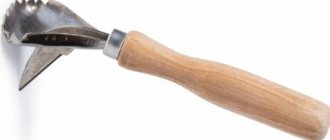When it comes to cleaning fish or how to skin salmon, it becomes clear that a knife is very important for this job. But all cutting products cannot work well to remove bones or fibers from fish or meat. Only a flexible fillet knife can help you remove the extra bones. There is quite a large selection of fish scalers. They help you clean the product for your favorite dishes or after fishing.
Special knife for cleaning fish.
Cleaning process
Before cleaning begins, no matter what type of equipment is used, the fish should be prepared for this process. To do this you need to do the following:
- Live fish should be stunned so that they do not resist.
- Trim fins. This can be done using scissors.
- Place the fish on a cutting board and secure the tail. In this case, it is desirable that the board has a special clamp. It is recommended to wrap the board with cling film.
- You can place the fish with the board in a sink filled with water.
Next, holding the fish by the tail, use a cleaning device to begin cleaning off the scales, moving from the tail to the head. If a board with fish is placed in a sink, the peeled scales will immediately fall into the water and will not scatter around. After the fish is cleaned, it must be rinsed with water and gutting begins.
Board with clamp for holding fish.
Distinctive features of fish cleaning knives
If you are interested in purchasing a new fish scaler, there are a few features to look at before purchasing. So, what do you need to know before purchasing a fish peeling knife?
Size
The size of the blade is an important part of this type of product. A very small blade may not perform better than a longer one. However, the size of the carcass must also be taken into account.
Steel
The steel from which the blade is made is of great importance. The best blade would be made of stainless material with anti-corrosion properties.
Lever
When cleaning fish, it is very important to hold the knife securely so that your hand does not slip and get injured on fins, scales or bones. Therefore, the material from which the handle is made, as well as its shape, are of great importance.
Weight
The light weight of a fish scaler will come in very handy when speed is very important. Because if your knives are heavy, you cannot work well on the cutting table. But the weight may depend on the blade material.
How to clean fish?
One of the popular cleaning methods is a knife. But from some types of fish you don’t have to remove scales at all, for example, salmon, gobies. This fish is simply fried in a frying pan. Catfish and burbot are quick and easy to clean; just wash off the mucus from them with water or rub the carcass with salt. The scales can be easily removed from freshly caught crucian carp simply with your fingers. Small fish can be sprinkled with salt and rinsed under water. But, ruff and perch, you will have to sweat over them.
A live fish that moves and constantly beats its tail is very inconvenient to clean, so it must be stunned. Let's start cleaning. The very first and most important step is to rinse the carcass under running cool water. It is necessary to wash the gills and body of the carcass well. You can clean with a regular kitchen knife, a special fish knife, as well as fish scalers and scrapers.
Hand tools
The mechanical cleaning method is the fastest, but not effective. Large fish can be cleaned by hand. Grasp the tail with one hand. The cleaning itself occurs with your free hand, that is, with your thumbnail across the growth of the scales. Use a knife to clean in hard-to-reach places.
An ordinary kitchen knife, not very large and wide. You need to be careful with him. To prevent the scales from scattering, the carcass can be placed in a bag, in which the scales can be removed with gentle movements. If you clean in the sink, do not forget to put a metal or plastic mesh over the drain. The carcass must be held correctly. The head should be positioned towards you, you need to hold it by the tail. The process of removing scales occurs from the tail to the head. Movements are smooth and neat.
The best tools include a brush that visually resembles a hair comb. This is a flat plate with small blunt teeth. Teeth - spikes are the main working part of the tool. This design can handle scales of different sizes without much difficulty.
It is worth noting that sometimes even a vegetable knife will do. It is better to clean under running water or in a bowl of water. Mini grater for chopping vegetables, the edges of which should be sharp. There are species of fish whose scales fit tightly to the skin. Then place the carcass in boiling water for a few seconds.
Read Jig fishing for beginners
Electric household fish scaler
One of the best devices that can quickly and easily clean fish scales is an electric fish scaler. Such an electrical device can be found in most fishermen, catering workers and owners of private fish stores.
A fish scaler runs on electricity and is considered the most convenient and easy-to-use tool. Home automatic scale removal machines can operate from several power sources: a household network, a car cigarette lighter, and a built-in battery. Thanks to these power options, you can use the device not only at home, but also while fishing.
Electric household fish scalers are also very popular. The most famous models are RF 01, VesElectric 4000 battery with container. Electric household fish scalers are equipped with a special screen that prevents scales from flying away.
Types of knives for removing scales from fish
A fish scaler is a tool that makes scale removal faster. From products with an extra cutting edge to electrical devices, they come in all shapes and sizes.
All fish knives have some kind of ribbed edge or sawtooth surface to remove scales from the skin. When cleaning, it is important not only to save time and effort when scraping scales, but also to avoid the mess from flying scales.
With a fake edge
The need to clean and cut fish can confront you with quite a significant assortment. For example, a blade with a false sharpening. On the reverse side there is another cutting edge specifically for cleaning and not for slicing. It also copes with peeling scales and planing fillets.
Fish knife with false sharpening.
With serrated sharpening
A product with serrated sharpening is, in other words, a saw. The cutting edge of the knife has teeth of different sizes and frequencies. It makes cleaning easier because the sawtooth shape of the blade allows you to use less force. True, such a knife is difficult to sharpen.
Fish cleaning knife with serrated sharpening
With long flexible blade
You can often find elegant knives with a thin curved blade. In addition to the attractive price, this product has the ability to get rid of small parts. However, it is important not to overdo it with miniaturization, otherwise you will have to use significant effort during work.
Fish cleaning knife with a long flexible blade.
Fish scalers with teeth and notches
There are models that have been widespread since Soviet times, which are reshaped metal plates with notches on the sides. This fish scaler easily picks up scales and prevents them from flying around the room. You need to choose a high-quality knife so that it does not become deformed during operation, otherwise you can injure your hand.
Serrated fish cleaning knife.
With container for collecting scales
Plastic fish scalers, designed for collecting scales, are very convenient and easy to use. You just need to make forward movements along the fish carcass and from time to time empty the container with the scales accumulated there. However, plastic devices are not suitable for very large scales and, unfortunately, break quickly.
Fish scaler with container for scales.
Electric fish scaler
An electric cleaner can be a real lifesaver if you need to work on more than one fish. The device, which runs on a battery, is also mobile. It can be equipped with a container for collecting scales and a waterproof housing. Of course, the cost of such a model will be appropriate.
Some people stick to the good old manual cleaning method. Mains or battery powered knives are mainly used for commercial use. This can significantly save effort and time.
If you are not a professional and cut fish occasionally, an ordinary hand knife will suit you perfectly.
Electric fish scaler in action.
Two ways to clean perch
As you know, this type of fish has very small scales, which are also dense and hard. Often cleaning it turns into real flour.
The first method involves peeling the scales directly, while the skin itself remains on the fish. Then, when frying, you get an appetizing crispy crust. So.
- First you need to boil a kettle of water and scald the perch a little (by the way, tench are also stubborn in processing).
- Then the fins are removed with scissors. For convenience, wear gloves.
- Most of the time is spent cleaning the carcass. It is better to do it with any tool, but not along, but across the ridge. This way the scales are removed much easier, faster and do not fly in different directions. With this method, a basin of water is not needed.
The second method, in which the skin is removed, is more effective, but it depends on who you like. Many argue that the skin is the most delicious, and fillets can be bought in the store. What should be done:
- They start by making a shallow cut along the ridge on both sides of the fin. The main thing is to cut through the skin. The knife must be very sharp.
- Then, remove the dorsal fins and with a slight movement of your fingers (across the spine) separate the skin from the meat. In this breed it peels off easily.
- At the end of the process, the head of the fish is cut off, but not all the way, but only the main bone.
- A finger is inserted into the belly and all the insides are removed, and the remaining skin is removed like a sock. The tail is cut off, resulting in a mouth-watering fillet with a backbone.
Tricks for cleaning fish
Any fish will be easy to clean if its tail is pinned to the board. This cleaning method has been used for a long time. By the way, regarding the knife, it is better to clean it with the blunt side rather than the sharp side. But this method is not suitable for beginners.
Electric fish scalers do their job very quickly; the only drawback is that they are expensive. If your husband brings back several crucian carp from fishing, it is better to use the old grandfather’s method. Using beer caps and parkas is a method used by fishermen.
But it is worth noting that the plugs, which are currently not suitable for cleaning, are weak and with a large number of fish, the wavy teeth will bend.
It is better to clean only fresh fish
If you buy it at the market, pay attention to the gills, they must be red, without mucus and mud. The smell should be fishy, without foreign aromas, there should be no mucus present, the scales should adhere tightly to the skin
Read: Proper spinning rod equipment
Don't be afraid of Chinese purges; they do their job well. The simplest and easiest way to clean fish is with a knife and the experienced hands of a fisherman. As you can see, cleaning fish is easy; you just need to have certain skills and a special cleaning device.
Remember that it is best to clean only fresh fish. If you want to freeze a product, you must clean it, wash it, and only then freeze it. Choose for yourself the cleaning method that will cope with the task perfectly.
Classification of devices
Cleaning the scales is done in the usual mechanical way - the scales are simply separated from the skin of the fish using some hard object that can cling to it. The following devices can serve as a device for separating scales from the skin:
- regular knife;
- special (sharp) knife;
- scraper;
- scaler.
The first three fish cleaning devices are manual. When using them, the movement accompanying the separation of scales from the body of the fish is performed by a person. The use of such devices requires some experience and skill, since the cleaning process is relatively complex and always leads to contamination of the surrounding space. Along with the scales, scraps of skin, blood, mucus, etc. fall off the fish.
Fish scalers are semi-automatic devices in which scales are separated using some external energy source that moves or rotates the working fluid. The role of a person in this case is reduced to moving the device along the length of the fish, or even simply to fixing the fish’s body by the tail and further monitoring the process. Usually this method is faster (sometimes by an order of magnitude) and more hygienic: traces of fish cleaning can be removed very quickly.
Important! Despite the apparent attractiveness of automatic scale removal, this method has one significant drawback (actually two: the second is the price of the device) - although it is fast and clean, it is also of lower quality. In fact, with the help of automatic special means for removing scales, about 3–5% of it remains on the carcass, and they require little manual processing
In fact, with the help of automatic special means for removing scales, about 3–5% of it remains on the carcass, and they require little manual processing.
Prices for fish scalers
The average price for these devices is about 4 thousand rubles.
The advantages of fish scalers include:
- Speed and quality of cleaning.
- Easy to use.
- Mechanical fish scalers are much cheaper than electric ones.
- When using electric fish scalers, the cleaning process is much faster, although there is a possibility of damage to the fish flesh.
- The scales do not scatter in all directions, unlike conventional cleaning methods.
Making a device for cleaning fish with your own hands
For effective cleaning, there are various graters that can be purchased at the market or in a store. But you can make the device yourself. To do this, you will need a wooden block and tin with holes, which has sharp jagged edges. This device will clean the fish instantly.
Let's make a grater from a tin can. To do this, make several medium-sized holes in it. Beer cap grater. Take a wooden block, such that it is comfortable to hold in your hand. You need to nail several tin beer caps to it. The device turns out to be simple and effective; scales fly off the fish quickly.
If you don't have a lid or an empty can at home, use a simple fork or spoon. The scales can scatter a lot, so place the fish in a plastic bag.
Read Catching smelt in winter
How to clean fish without special equipment
In a situation where you need to clean fish, but for some reason the necessary equipment is not available, people can resort to various means. You can modify a regular tin grater. You can use the hidden capabilities of cutlery: the handles of a spoon or fork cope with small scales.
A vegetable peeling device also copes well with a similar task. And an unsurpassed design solution is to attach beer caps to a wooden plank. In general, if you don’t have a fish scaler, but you have fish, there is always a way out.
Is it possible to clean fish with a regular knife?
And finally, you can clean the fish with a regular knife, turning the butt towards the scales. This will be quite effective, although you will have to make additional physical efforts and use skill.
Previous
KnivesKnife sommelier
Next
Kitchen knives Potato knife: French fries, peeling and cutting
Sanitary standards for equipment
The most commonly used kitchen boards are wooden ones. Unfortunately, of all types of cutting surfaces, wood is by far the most difficult to clean hygienically. If the housewife still decides to use it for cutting fish, then she needs to choose a model made of hardwood. The harder the wood, the better, but the price of such a product will be higher.
Regularly wiping equipment with a cloth or sponge soaked in a vinegar mixture will keep your family safe. If you add one teaspoon of soda to half a liter of warm water, the effect will increase. The main thing is to cover hard-to-reach cavities of the cleaner and cuts on the board or table for cleaning fish with liquid. Well, lemon juice will help get rid of unwanted odors.
https://youtube.com/watch?v=-33gp1YFyQM
People's Councils
I’ll tell you my secret: in order for the small bones of the fish to soften during frying, it must be cut with a very sharp knife diagonally along the ridge towards the back. Then you don't feel them at all.
Ivanna, Poltava
To make it easier to peel off the scales, I pinch the tail of the fish with a fork, and with my free hand I grab the eyes and pull out the carcass until there is a characteristic crunch. Very effective.
Fisherman
If we cut raw fish or meat on a wooden board in a cafe, we use hydrogen peroxide to carefully and efficiently clean the board.
Anna Osipovna, Moscow
I use the blade of a pocket knife and peel diagonally rather than under the husk. But I also use a fork in the same way. That's all. Within half an hour I can scrape about 10 perch using my method.
Nikita spawning
Tips for cleaning fish
Firstly, it should be remembered that freshly caught fish is always much easier to clean than fish that has been stored for some time.
- As a rule, the best option is to clean the caught fish directly near the reservoir.
- To cut fish, it is better to use only sharp and high-quality knives.
- Cleaning of fish is carried out exclusively on a special cutting board for fish.
- The cleaning process must be careful and of high quality. The quality of the cooked fish will depend on this.
- Before starting such a process, it is advisable to place the fish in cold water with vinegar.
- It will be much easier to clean the fish if you insert a wooden stick into its mouth all the way or fix its tail on the board itself. Holding the fish by the eyes with your fingers, pull it out until a characteristic crunch appears.
- To hold the fish firmly with your fingers, you can wrap the tail of the fish with a napkin or rub your fingers with salt if there are no abrasions on them.
Preliminary manipulations
Oddly enough, in order to enjoy the freshness of the product and not experience difficulties with cutting it, it is best to process live fish
If this is not possible, then you need to pay attention to several details when choosing the right copy. He must have:
- pleasant and fresh aroma;
- the eyes are transparent, shiny and protruding;
- tightly fitting scales;
- the skin is moist and slippery, but not sticky;
- gills with a pale red color, which when pressed should return to their original shape.
It’s more difficult with a living specimen.
For many fishermen, the gambling hobby ends with the removal of the trophy from the hook. They, happy and dirty, return home with their prey still alive and prefer not to interfere with the cooking process anymore. Then the “lucky” keeper of the hearth is faced with the task of killing the future culinary masterpiece. It is not difficult to do this painlessly for the fish and the psyche of the hostess. The best way is to “euthanize” the monster by putting it in the freezer for 10 minutes. If the process takes place in field conditions, then the fish is stunned with one clear blow to the head with a blunt object, but from the back and slightly above the eyes. It should not be too powerful so as not to damage, first of all, yourself. This can be trusted to the stronger half. For convenience, wrap your hand in a towel. After stunning with a sharp knife, the spine is cut directly behind the head. The semi-finished product is ready and you don’t even have time to get scared.











